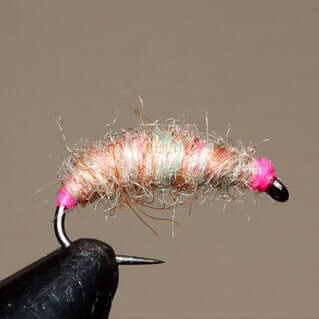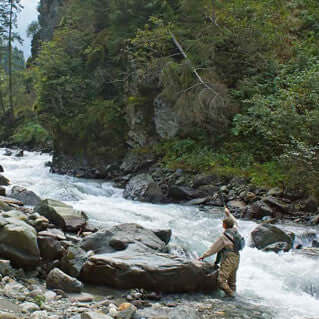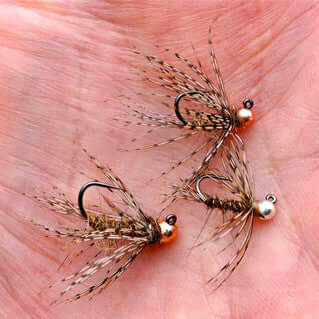We all have our favourite flies...
the ones that we feel confident will fool the fish most of the time (as long as we present them well). I’m not a great believer in ‘Magic Flies’, being firmly of the opinion that (as long as you haven’t scared the fish) presentation is 90% of the game, but there is always that other 10% & as the late Dick Walker (one of my early fishing heroes & a great all-rounder with coarse & game fish) used to say “You can’t catch 90% of a fish!” If the grayling are preoccupied with a particular food source then we obviously need to choose an appropriate pattern.
Winter grayling are feeding subsurface
For instance on the rare occasions in winter when they are rising to minute Midges a size 20 CdC IOBO Humpy might well be ignored, but a size 24 will be engulfed without hesitation. Unfortunately during most of the winter grayling are feeding subsurface & we have to make educated guesses as to what they might be eating or use an attractor pattern that although it has no resemblance to anything in nature it has triggers that induce a fish to take. Fortunately for us fly choice in winter is less important than when there are specific hatches. The winter invertebrates are generally well hidden & the fish have to feed opportunistically. Some of my favourite flies are imitative, some are suggestive & in several cases I opt to exaggerate what I believe to be key trigger points.
For a long time ethologists have known about Supernormal Stimuli that elicit exaggerated responses & often these behavioural triggers are very simple. For example ethologists Conrad Lorenz & Niko Tinbergen noticed that male sticklebacks would attack anything red, even the image of a Post Office van seen through the glass of their tank, thinking it to be another male. In the breeding season male sticklebacks will attack any large red object in preference to other red-throated males that are vying for their territory.
Oddity Selection
There are many other examples of such increased response to exaggerated triggers. Niko Tinbergen was one of the first people to study this phenomenon in depth & we anglers can make good use of it when designing flies. Yet another interesting behavioural response of many vertebrates that we can exploit is Oddity Selection, a phenomenon where predators tend to select prey that differ slightly from normal in either their appearance or behaviour, for example pike attacking a struggling fish, but ignoring those behaving normally. So what are my favourite grayling-flies?
Orange & pink Gammarus
On my local chalk stream, Driffield Beck the grayling feed largely on Gammarus (freshwater shrimps). These crustaceans contain carotenoid pigments, which give them a yellowy-orange tinge.

Furthermore an Acanthocephalan parasite (spiny-headed worm) (Pomphorhynchus laevis) exploits this fact. This parasite has two life stages, one in the shrimp & the other in a fish. Whilst in the shrimp it accumulates the carotenoids, producing a bright orange spot, making the shrimp more visible & appealing to the grayling, trout, etc., furthermore it upsets the shrimp’s hormone balance making it more active in the light/open, making it even more likely to be eaten by the primary host (the fish). Thus highly visible orange shrimps provide a Supernormal Stimulus.
The appeal of pink shrimps is an undoubtedly an example of Oddity Selection as well as increased visibility. The UVSP Shrimp exploits both phenomena (orange & pink) as the ultra-violet shrimp pink Ice Dub used shimmers in both colours. The UVSP Shrimp has accounted for a couple of my 3lb plus grayling, whilst a bright Pink Shrimp has accounted for a third over this magic weight.

UVSP Shrimp
Hook; Grub sizes 16 to 8
Thread; 8/0 Orange, pink or tan
Body; Ultra Violet Shrimp Pink Ice Dub
Under-body: 2 layers of lead wire (top layer shorter than the base layer) flattened vertically.
Back; Grey or tan Scud back or similar (1/8th or ¼ inch)
Rib; Gold, pink or copper wire

Utah Killer Bug Variants (orange & pink)
This simple fly is a modification of Frank Sawyer’s deadly Killer Bug that he devised to rid his beloved Hampshire Avon of grayling which up till recently were considered to be vermin on many chalk streams in the UK. The original version of this variant devised by Utah Tenkara Guides used pink wire & Shetland Spindrift wool but I substitute lead wire covered with pink or orange floss as the underbody. The UV pink or orange floss glows through the single layer of wool when wet & is exposed at each end to add increased attraction.
This fly, particularly the orange version has caught a lot of grayling for me, up to a fraction short of 3lb. With just one layer of wool the colour of the underbody glows through giving a real semblance of translucency.
Hook: Grub size 18 to 8
Thread: Glowbright #2 Pink Floss or #7 orange)
Under-body/weight: Lead wire covered with pink floss) (1 layer)
Body: Utah Killer Bug yarn (Shetland Spindrift Yarn, colour - oyster) It helps to coat the floss underbody with Superglue before overlaying with the wool as this stops the wool sliding down the taper at the hook eye.

Squirmy Worms (red & pink)
Love them or hate them, these have proved to be highly successful, particularly in coloured water. Super Normal bright colour & probably size since whilst most aquatic worms are small some are as big as earthworms, plus Oddity Selection in the case of the pink variant probably account for their effectiveness. Other key features are translucency, mobility & softness. A somewhat similar Red Sparkle-braid Worm has accounted for one of my 3lb plus grayling.
Hook: Size 14 grub or Jig
Thread: 8/0 red (only used to tie the wire in & tie off
Wire: Red or pink medium (used to tie in the Squirmy material since thread will cut through)
Tail(s)/body: Red or pink Squirmy Worm material
Weight: Tungsten beads, 2mm to 4mm (Squirmy material is buoyant so a bead is essential)

Bead-head Partridge & Hare’s Ear Spider
This is a more natural, cryptically coloured pattern that is suggestive of a number of aquatic invertebrates & drowned insects including Sedge pupae, Gammarus & Heptageneid nymphs. If you want something extra then a pink, orange or purple collar behind the bead will provide an extra trigger. The basic pattern has accounted for two of my 3lb plus grayling & many smaller fish.
Hook: Jig size 16 to 10 (the use of a jig hook significantly reduces the frequency of snagging on the river bottom)
Thread: Brown 6/0 or 8/0
Tails (OPTIONAL): 5 or 6 fibers from a brown partridge hackle
Body: Hare’s ear/mask dubbing
Rib: Copper or gold wire Hackle: Brown English partridge
Head: Silver (copper, black, etc.) slotted tungsten bead, sizes 2.5 mm to 5 mm

Small Bead-head Nymphs
I have found that there are times when grayling just want very small nymphs or Midge pupae & when they will studiously ignore anything bigger. Some of my best grayling, including a fish of 2lb 10oz, have fallen for size 24 or smaller nymphs/buzzers. Last year I introduced a friend to tiny pheasant tail bead-heads & the next time I saw him he told me of a day when he had had about 50 grayling with virtually all taking his size 20 nymph rather than other, bigger, offerings.
As I’ve said before, I believe that good presentation is more important than fly choice but there are times when you just need the right fly to improve your chances. In a future Blog I’ll be talking about New Zealand fish that are fixated on tiny Willow Grubs, a situation where fly choice & spot-on presentation are critical. In conclusion I would urge all keen grayling anglers to join the Grayling Society who do lots of good work to protect & understand grayling stocks through their research branch.
































